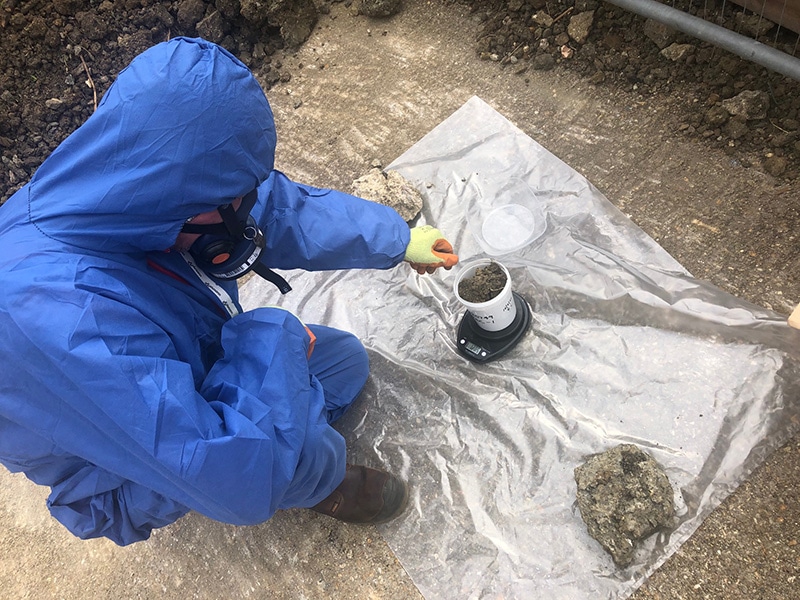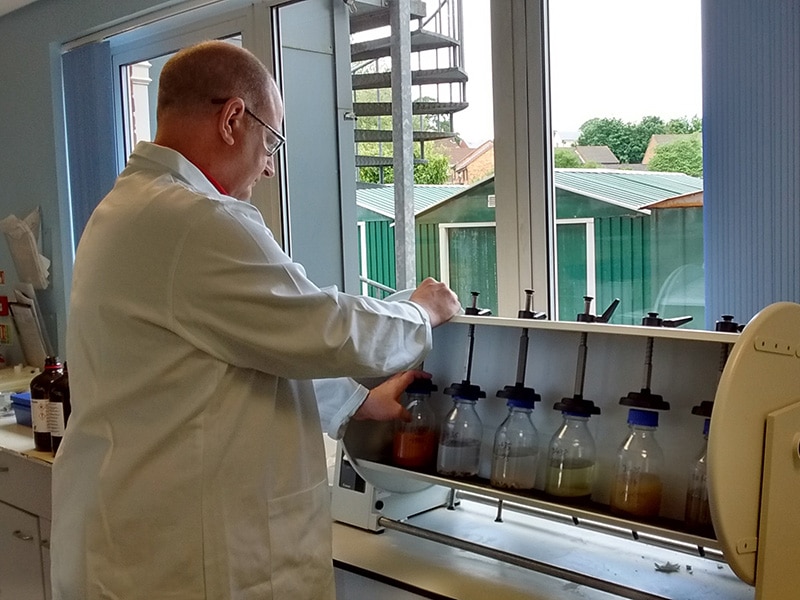How Much Does WAC Testing Cost in 2025?
A central element of the responsible and safe management of land and soil is being alert to the possibility of such land being contaminated with hazardous materials, such as asbestos. If you are overseeing a project that involves you managing land you know or suspect is contaminated with asbestos, it is of critical importance to know your legal obligations in relation to this, and to comply with those requirements.
Among those legal processes and requirements is Waste Acceptance Criteria (WAC) testing. It is necessary for waste to be categorised and to satisfy specific WAC, prior to it being disposed of at a landfill site.
However, if you need to arrange for WAC testing at land you are managing, you may be anxious to do everything possible to control the costs associated with this process, and to ensure you do not spend too much unnecessarily. So, with this in mind, we have below set out the essentials of how much you can expect WAC testing to cost for your particular site and requirements.
What are the basics of WAC testing in environmental management?
The Waste Acceptance Criteria, or WAC, was conceived amid efforts by the UK Government to reduce reliance on landfill as a means of disposing of waste, as well as to help lessen the adverse impact that landfill had on both the environment and human health.
With the introduction of the Landfill Regulations (2005) and the Waste Framework Directive (WFD) (2008/98/EC), a statutory requirement was put in place for waste to be categorised, in addition to complying with specific WAC, before it could be disposed of at a landfill site.
To this day, both waste producers and landfill operators are subject to certain legal obligations. The former have a ‘duty of care’ to make sure the waste they produce is categorised, while the latter must not accept the given waste until they are satisfied that a ‘basic categorisation’ has been properly completed.
WAC testing is of the utmost importance, for reasons that far transcend the need to stay on the right side of the law. This is because, in the absence of such testing, the materials that end up in landfill could present major risks to both human health and safety and the broader environment.
This helps to explain why WAC testing is also crucial for land and soil that contain asbestos. This fibrous silicate mineral, banned in the UK since 1999, can find its way into the ground, such as in the case of sites where a building containing asbestos may have once stood and subsequently been demolished. So, the most responsible measures must be taken to guard against possible asbestos risks arising from contaminated land and soil.
Why is there Asbestos in land and soil?
Asbestos was first commercially mined in the middle of the 19th century, and went on to be used in an exceedingly broad range of products in the UK over the course of the 20th century. This largely due to such noted advantages of the material as its relative affordability, availability, physical strength, fire resistance, and effectiveness as an insulator – all of which should make its once-heavy use in construction unsurprising.
As public awareness grew of the health risks of breathing in or ingesting asbestos – such as the development of potentially fatal diseases, like asbestos-related lung cancer and mesothelioma – the importation and use of the substance was finally banned in the UK in 1999.
For the bulk of the 20th century, however, asbestos was incorporated into building materials encompassing such products as asbestos insulating board, thermal insulation, cement, floor tiles, textured coatings, and many more.
With historical regulations governing how asbestos is managed in the UK – including in buildings set for demolition – not having always been as stringent as they are today, it was all too easy in decades past for asbestos waste to end up being spread across demolition and construction sites.
It can be easy to imagine that with asbestos fibres often being spread out over such wide areas of land where they might contaminate the soil, they might not pose as much of a health risk as they do when they are contained within intact products in buildings.
However, as we have previously written about, the asbestos that is present within contaminated land or soil can pose its own serious health risks. This is partly because such asbestos-containing materials (ACMs) can often be damaged and fragmented, as well as because heavy machinery – as might be used for excavation and land works – can potentially cause asbestos fibres to be freshly disturbed and released into the air.
Although the subject of asbestos on or in contaminated land, soil, or waste is not fully explained within the UK asbestos regulations as they currently stand, those managing such asbestos nonetheless must ensure compliance with those regulations, including the Control of Asbestos Regulations 2012 (CAR 2012). Otherwise, they may face prosecution from the Health and Safety Executive (HSE).
What is the process of WAC testing for asbestos?
Prior to the WAC testing itself being carried out, it will be necessary to take the preliminary step known as the ‘waste classification test’. The point of this process is to determine whether particular organic material is hazardous or non-hazardous. The classification that the waste is given will determine the type of WAC testing required.
Once the given waste has been classified as hazardous or non-hazardous, the WAC testing itself will be undertaken, looking at both the solids and leachates (liquids that take in substances from the material through which they pass) of the material.
WAC testing analyses the soil or construction/demolition material for a range of contaminants; the results of this process determine which landfill facility is permitted to accept the material for disposal. This is in acknowledgement of the fact that different types of landfills exist, including for inert, non-hazardous, and hazardous waste.
WAC testing is crucial for determining how particular waste will behave once it has been buried in a landfill. It is primarily laboratory analysis of the leachate derived from the waste that will enable this determination to be made.
Included within our own WAC testing analysis at Oracle Solutions is an asbestos screen. This provides both a qualification and quantification results as to whether asbestos is present in soil, along with a weight ratio percentage of the amount of asbestos contamination present. The hazardous waste regulations confirm hazardous asbestos waste to be any material containing 0.1% or greater asbestos contamination.
The testing process also confirms whether loose fibre or fibre bundles are present within the soil. This can influence whether a licensed asbestos removal contractor will be required to assist with removal of the soil, along with potential disposal requirements.
What factors influence WAC testing costs?
There are various factors that dictate the typical costs of WAC testing. These factors encompass the likes of laboratory fees, the types of tests carried out, and the sample collection process, as well as the extent of the given site’s contamination, and the overall size of the site. Such requests as expedited testing and/or specialised analysis will also further impact on the cost.
The costs of our own WAC testing services are inclusive of a hazardous waste online report. This report will provide a summary for classifying whether the waste is of a hazardous or non-hazardous nature, which can then be passed onto your waste disposal supplier.
Sample analysis costs are as follows:
- For a turnaround of three working days: £550 +VAT per sample
- For a turnaround of five working days: £450 +VAT per sample
- For a turnaround of seven working days: £375 +VAT per sample
On top of the aforementioned analysis rates, a consultant callout fee needs to be accounted for. This is generally priced on a quarter-day, half-day, or full-day basis, subject to site location and the number of samples required.
It should be noted that these costs do not include site visit costs, which are dependent on time spent on site, as well as location. The costs outlined in this article should be considered an approximate guide only, rather than an indication of exactly how much you can expect to pay for WAC testing.
There may be some scope for movement in the price that one ultimately pays for WAC testing services, based upon economy of scale. In the case of large projects that entail the collection of high volumes of samples, we typically reduce our rates, so this is another factor to consider.
What are the economic implications of WAC testing?
As is so often the case when it comes to obligations to carry out testing processes in relation to asbestos, it can be tempting for many of those responsible for certain sites to ask themselves whether potentially expensive processes such as WAC testing are truly necessary.
However, as we touched on above, in the UK of today, stringent regulatory requirements apply to the management of asbestos-containing materials (ACMs) on a broad variety of sites, including where land or soil may be contaminated with this potentially lethal substance.
In the event of your soil waste being classified as non-hazardous, you won’t need to arrange WAC testing for it, unless you are considering disposing of it at an inert landfill. If you aren’t considering doing so, you can have the waste sent to a non-hazardous landfill. But if the waste is classified as hazardous, WAC testing will be required, in order to demonstrate it satisfies the acceptance criteria for hazardous landfill or stable non-reactive hazardous (SNRL) landfill.
When you are carrying out a cost-benefit analysis in relation to possible WAC testing on a contaminated site for which you are responsible, you will need to take into account the likely long-term financial implications that could arise if you were to neglect the need for proper testing. Such implications could include the need for more expensive remediation work later, and potentially fines or even more severe legal consequences if you fail to meet your legal obligations.
If you are concerned about the costs involved in arranging for WAC testing for your site where asbestos contamination is known or suspected, it could be well worth researching the funding and grants that may be available near you for environmental testing and cleanup.
Conclusion: WAC testing can be an extremely wise investment for more reasons than one
The importance of WAC testing for asbestos in land and soil must never be underestimated. There are well-established legal requirements that the owners and managers of asbestos-contaminated sites must comply with, and possible consequences for failing to do so include prosecution and fines.
Even putting aside whether one is legally compelled to arrange for such testing, it cannot be emphasised enough how important this process is for better protecting our precious environment and human health. So, playing your own part in ensuring proactive and careful environmental management at a site for which you are responsible, can greatly help you minimise and control a range of risks over time.
When you are seeking out and comparing quotes for WAC testing services in relation to your asbestos-contaminated land, you will need to carefully balance the three critical priorities of cost, safety, and regulatory compliance.
Are you on the lookout for comprehensive and competitively priced WAC testing and related services for land or soil that is suspected or confirmed to be contaminated with asbestos? If so, please don’t hesitate to call the Oracle Solutions team or send us an email; we would be happy to show you the benefit of a fast and free quote.
Additional Cost Guide Resources
For more information about the cost of removing asbestos, and the types of removals, see our growing resource of removal related information.
- Asbestos Removal Cost Guide
- Asbestos Artex Removal (Textured Coating) Cost Guide
- Asbestos Bitumen Glue Adhesive Removal Cost
- Asbestos Boiler & Flue Removal Cost Guide
- Asbestos Ceilings & Ceiling Tile Removal Cost Guide
- Asbestos Cement Roof Sheeting & Wall Cladding Removal Cost Guide
- Asbestos Cement Water Tank Removal Cost Guide
- Asbestos Floor Tile Removal Cost Guide
- Asbestos Garage Roof Removal Cost Guide
- Asbestos Insulating Board Removal Cost Guide
- Asbestos Pipe Insulation & Lagging Removal Cost Guide
- Asbestos Roof Tile Removal Cost Guide
- Asbestos Soffits & Fascia’s Removal Cost Guide
- How much does an asbestos survey cost?

Written by Mark Carter
Mark Carter is a renowned expert in asbestos management, offering clients vital guidance on compliance and safety. His expertise is invaluable for navigating asbestos regulations, ensuring both safety and legal adherence. Mark's role is central in providing effective asbestos-related solutions, helping clients achieve their business objectives with an emphasis on regulatory compliance and safety in asbestos management.


